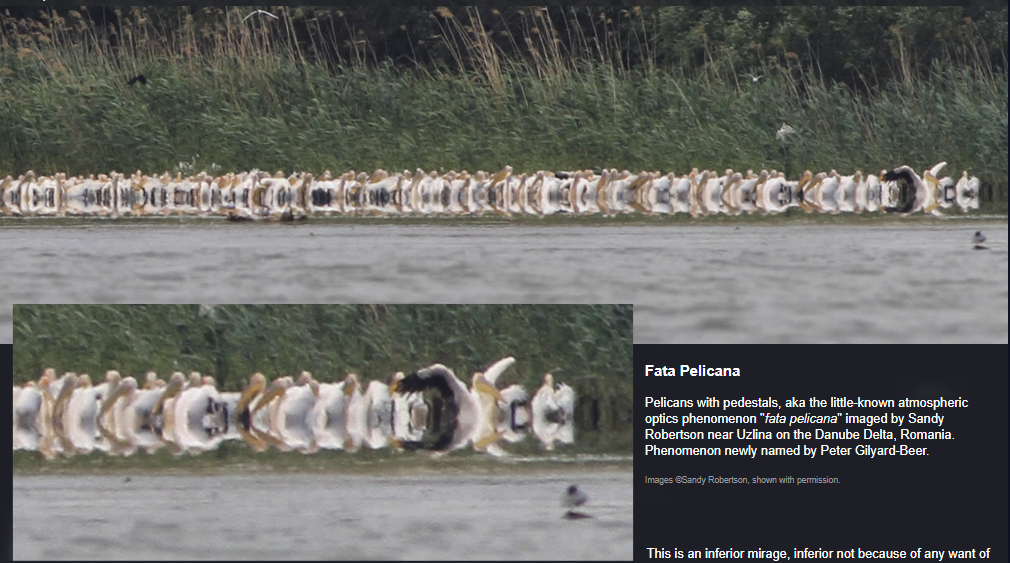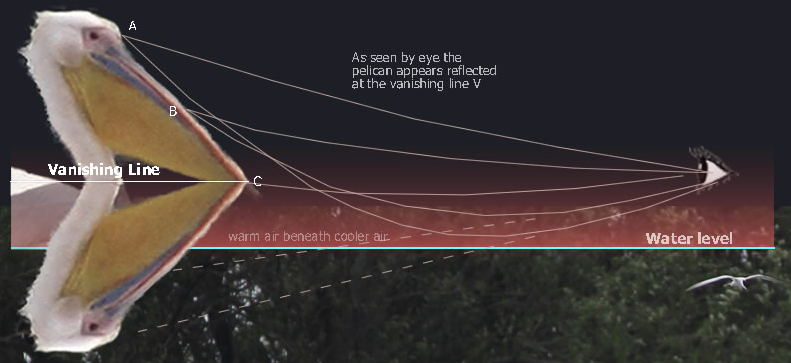OPOD - Fata Pelicana
Fata Pelicana: Exploring the Phenomenon of Inferior Mirage
Have you ever heard of "fata pelicana"? It's a little-known atmospheric optics phenomenon that was recently imaged by Sandy Robertson near Uzlina on the Danube Delta in Romania. This fascinating phenomenon has been named by Peter Gilyard-Beer and involves pelicans with pedestals. In this article, we will delve deeper into the concept of fata pelicana and explore the intriguing science behind it.
Understanding the Inferior Mirage
Fata pelicana is essentially an example of an inferior mirage. The term "inferior" does not refer to any lack of quality, but rather describes the mirage image appearing below the original object and being inverted. In the case of fata pelicana, the pelicans are mostly in the water, but their lower parts become invisible due to the "vanishing line" effect.
The Curvature of Light Rays
To comprehend how fata pelicana occurs, let's examine the path of light rays. When we observe the pelicans, two rays from their heads reach our eyes. The upper ray is slightly curved downwards towards the warmer air, while the lower ray appears sharply curved, creating the illusion of a head reflected by a mirror. This phenomenon is similar for rays originating from lower down on the pelican's body.
The Vanishing Line
The key element in fata pelicana is the concept of the mirage vanishing line, represented by position (C). At this level, the "real" view and the inverted mirage view merge, and our eyes are unable to perceive any details of the scene below this line. Consequently, any rays from lower parts of the pelican's body cannot reach our eyes, rendering them invisible.
Exploring the Camera and Eye Height
It's worth noting that mirages can exhibit significant changes depending on the height of the camera or observer's eye. Sandy Robertson captured the fata pelicana phenomenon using a 400mm lens, with the camera positioned approximately 1 meter above the water. This specific setup allowed for the unique visualization of the inferior mirage.
The Intricacies of Mirages
Mirages, including fata pelicana, offer a captivating glimpse into the complexities of atmospheric optics. These optical phenomena occur due to the bending of light rays as they pass through layers of air with varying temperatures and densities. Understanding the science behind mirages involves comprehending concepts such as refraction, temperature inversions, and the interplay between warm and cool air masses.
Experimenting with Mirages
If you're intrigued by fata pelicana and want to explore mirages further, you can conduct your own experiments. By adjusting the height of your camera or eye, you can observe how mirages change. Try capturing images or simply observing the environment from different perspectives to witness the intriguing variations in mirage formations.
Final Thoughts
Fata pelicana, with its pelicans on pedestals, is an enchanting example of an inferior mirage. Through Sandy Robertson's stunning photographs, we gain a glimpse into this lesser-known atmospheric optics phenomenon. Exploring the science behind fata pelicana and mirages in general reveals the fascinating interplay between light, temperature, and our perception of reality. So next time you find yourself near a body of water on a warm day, keep an eye out for any mirages that may captivate your imagination.

Fata Pelicana
Pelicans with pedestals, aka the little-known atmospheric optics phenomenon "fata pelicana" imaged by Sandy Robertson near Uzlina on the Danube Delta, Romania. Phenomenon newly named by Peter Gilyard-Beer.
Images ©Sandy Robertson, shown with permission.

This is an inferior mirage, inferior not because of any want of quality but because the mirage image is below the original object and inverted.
The pelicans are mostly in the water but their lower parts are invisible because of the 'vanishing line' effect.
At left, two rays from the pelican's head (A) reach the eye. The upper one is slightly curved downwards towards the warmer air. The lower ray from (A) is sharply curved and appears to the eye to come from a the head reflected by a mirror. Rays from point (B), lower down, do the same. Position (C) is different. Only one ray reaches the eye. Rays from lower down the pelican's body cannot reach the eye at all and so it is invisible.
The level (C) is the level of the mirage vanishing-line. The 'real' view and inverted mirage view join at the vanishing line and the eye can see no details of the scene that are below it.
Sandy used a 400mm lens and the camera was ~1m above the water.
Mirages can change dramatically with camera or eye height - try it.

Note: this article has been automatically converted from the old site and may not appear as intended. You can find the original article here.
Reference Atmospheric Optics
If you use any of the definitions, information, or data presented on Atmospheric Optics, please copy the link or reference below to properly credit us as the reference source. Thank you!
-
<a href="https://atoptics.co.uk/blog/opod-fata-pelicana/">OPOD - Fata Pelicana</a>
-
"OPOD - Fata Pelicana". Atmospheric Optics. Accessed on November 26, 2024. https://atoptics.co.uk/blog/opod-fata-pelicana/.
-
"OPOD - Fata Pelicana". Atmospheric Optics, https://atoptics.co.uk/blog/opod-fata-pelicana/. Accessed 26 November, 2024
-
OPOD - Fata Pelicana. Atmospheric Optics. Retrieved from https://atoptics.co.uk/blog/opod-fata-pelicana/.